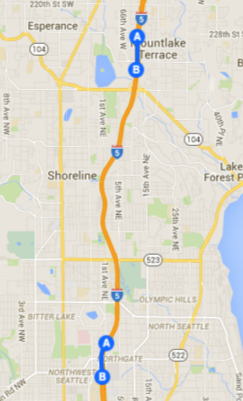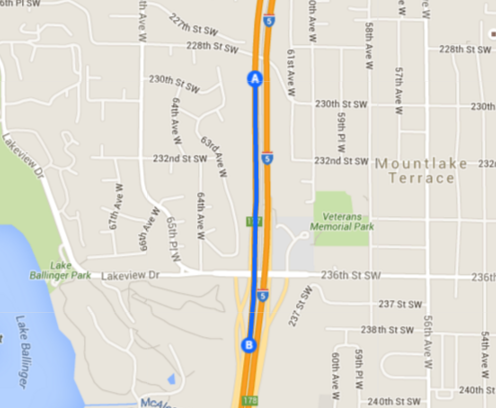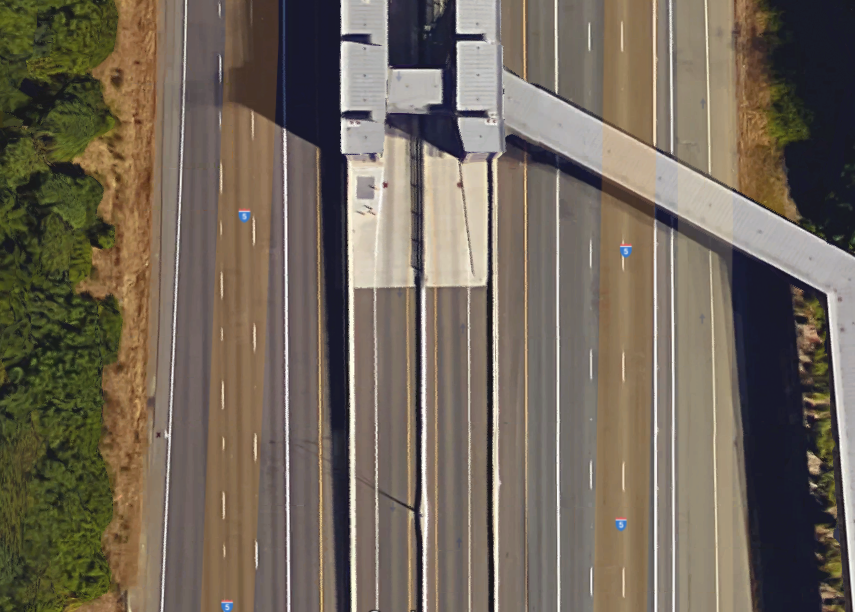
Community Transit continues to look at ways to improve speed and reliability of commuter routes. Coming on the heels of a new policy that allows shoulder driving on I-405 and a $2 million investment in I-5 running services to improve reliability performance, Community Transit will now utilize transit-only and collector ramps on I-5 to bypass traffic.
During heavy periods of congestion on southbound I-5, Community Transit and Sound Transit1 bus operators will be given discretion to deviate from HOV lanes to ramps at Mountlake Terrace Freeway Station and N Northgate Way (Exit 173). Each ramp is approximately two-thirds of a mile in length. Together, buses could travel one-and-a-half miles without the conflicts that other traffic present.
This policy is largely geared toward the morning commute where traffic along the corridor can be crippling — often with travel times between Everett and Seattle well over 90 minutes, despite a distance of about 30 miles. In many cases, traveling a mere mile on I-5 can take well over 10 minutes2, so it’s conceivable that this minor change could produce substantial time advantages further up the corridor if operators put the new policy into action.

In fact, firsthand experience on the Sound Transit 512 has shown that many bus operators have been making unsanctioned deviations for a long time now near the southbound N Northgate Way collector ramps. Bus operators often stay near the right lane after weaving back onto I-5 from the 145th Street Freeway Station when attempting this deviation. The reason operators do this is the bottleneck that forms at the end of the HOV lane. When the I-5 Express Lanes are closed, traffic from the HOV lanes are dumped back into mainline during the afternoon further slowing already backed-up traffic approaching Downtown Seattle and points in between.

In the morning commute, commuter buses going to the University District or making stops at NE 45th St will be able to take advantage of both ramps. However, commuter routes going express to Downtown Seattle will miss the Northgate deviation in favor of the I-5 Express Lanes and only have an opportunity to use the Mountlake Terrace Freeway Station ramp.
Community Transit says that the agency is working with the Washington State Department of Transportation to allow southbound buses to use the HOV ramp at Lynnwood Transit Center. Since HOVs — and not just buses — are able to use that ramp, special signage needs to be posted so that all motorists recognize that buses may continue through the intersections after stopping at the ramp crests.
For riders at the Mountlake Terrace Freeway Station3 subject to these changes, new signage will be posted to let them know that not all buses will stop at the platforms.
Footnotes
- Sound Transit routes 510, 511, 512, and 513 on I-5 are operated by Community Transit.
- The author rides the Sound Transit 512 regularly and has clocked the stretch of I-5 from N 85th St to NE 65th St, a distance of about one mile, often exceeding 10 minutes.
- Only Sound Transit routes 511, 512, and 513 and Community Transit routes 410, 413, 415, and 435 stop at the Mountlake Terrace Freeway Station for passenger pickup.
Stephen is a professional urban planner in Puget Sound with a passion for sustainable, livable, and diverse cities. He is especially interested in how policies, regulations, and programs can promote positive outcomes for communities. With stints in great cities like Bellingham and Cork, Stephen currently lives in Seattle. He primarily covers land use and transportation issues and has been with The Urbanist since 2014.


